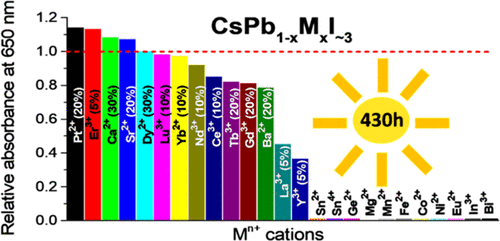当前位置:
X-MOL 学术
›
ACS Appl. Mater. Interfaces
›
论文详情
Our official English website, www.x-mol.net, welcomes your
feedback! (Note: you will need to create a separate account there.)
Partial Substitution of Pb2+ in CsPbI3 as an Efficient Strategy To Design Fairly Stable All-Inorganic Perovskite Formulations
ACS Applied Materials & Interfaces ( IF 8.3 ) Pub Date : 2021-01-21 , DOI: 10.1021/acsami.0c18061 Marina I. Ustinova 1, 2 , Maria M. Mikheeva 1, 3 , Gennadii V. Shilov 2 , Nadezhda N. Dremova 2 , Lyubov Frolova 2 , Keith J. Stevenson 1 , Sergey M. Aldoshin 2 , Pavel A. Troshin 2
ACS Applied Materials & Interfaces ( IF 8.3 ) Pub Date : 2021-01-21 , DOI: 10.1021/acsami.0c18061 Marina I. Ustinova 1, 2 , Maria M. Mikheeva 1, 3 , Gennadii V. Shilov 2 , Nadezhda N. Dremova 2 , Lyubov Frolova 2 , Keith J. Stevenson 1 , Sergey M. Aldoshin 2 , Pavel A. Troshin 2
Affiliation

|
All-inorganic lead halide perovskites, for example, CsPbI3, are becoming more attractive for applications as light absorbers in perovskite solar cells because of higher thermal and photochemical stability as compared to their hybrid analogues. However, a specific drawback of the CsPbI3 absorber consists of the rapid phase transition from black to yellow nonphotoactive phase at low temperatures (e.g., <100 °C), which is accelerated under exposure to light. Herein, an experimental screening of an unprecedently large series (>30) of metal cations in a wide range of concentration has allowed us to establish a set of Pb2+ substitutes, facilitating the crystallization of the photoactive black CsPbI3 phase at low temperatures. Importantly, the appropriate Pb2+ substitution with Ca2+, Sr2+, Ce3+, Nd3+, Gd3+, Tb3+, Dy2+, Er3+, Yb2+, Lu3+, and Pt2+ cations has led to a spectacular enhancement of the film stability under realistic solar cell operation conditions (∼1 sun equivalent light exposure, 50 °C). Optoelectronic, structural, and morphological effects of partial Pb2+ substitution were investigated, providing a deeper insight into the processes underlying the stabilization of the CsPbI3 films. Several CsPb1–xMxI∼3 systems were evaluated as absorber materials in perovskite solar cells, demonstrating encouraging light power conversion efficiency of 11.4% in preliminary experiments. The obtained results feature the potential of designing efficient and stable all-inorganic perovskite solar cells using novel absorber materials rationally designed via compositional engineering.
中文翻译:

设计CsPbI 3中Pb 2+的部分取代是设计相当稳定的全无机钙钛矿配方的有效策略
全无机卤化铅钙钛矿,例如CsPbI 3,由于与它们的杂合类似物相比具有更高的热和光化学稳定性,因此在钙钛矿太阳能电池中作为光吸收剂的应用变得越来越有吸引力。但是,CsPbI 3吸收剂的一个特殊缺点是在低温(例如<100°C)下从黑色到黄色非光敏相的快速相变,这在暴露于光下会加速。在这里,实验筛查了一系列浓度范围广泛的金属阳离子(> 30),这使我们能够建立一组Pb 2+替代物,从而促进了光敏黑CsPbI 3的结晶。相在低温下。重要的是,用Ca 2 +,Sr 2 +,Ce 3+,Nd 3+,Gd 3+,Tb 3+,Dy 2 +,Er 3+,Yb 2 +,Lu 3+和Pb 2+适当取代。Pt 2+阳离子在实际的太阳能电池工作条件下(约1个太阳当量曝光,50°C)导致了薄膜稳定性的显着提高。研究了部分Pb 2+取代的光电,结构和形态学影响,为CsPbI稳定的基础过程提供了更深入的了解3部电影。几个CSPB 1- X中号X我〜3系统被评价为在钙钛矿太阳能电池吸收材料,证明鼓励在初步实验中的11.4%的光功率转换效率。获得的结果具有使用通过组成工程合理设计的新型吸收剂材料设计高效,稳定的全无机钙钛矿太阳能电池的潜力。
更新日期:2021-02-03
中文翻译:

设计CsPbI 3中Pb 2+的部分取代是设计相当稳定的全无机钙钛矿配方的有效策略
全无机卤化铅钙钛矿,例如CsPbI 3,由于与它们的杂合类似物相比具有更高的热和光化学稳定性,因此在钙钛矿太阳能电池中作为光吸收剂的应用变得越来越有吸引力。但是,CsPbI 3吸收剂的一个特殊缺点是在低温(例如<100°C)下从黑色到黄色非光敏相的快速相变,这在暴露于光下会加速。在这里,实验筛查了一系列浓度范围广泛的金属阳离子(> 30),这使我们能够建立一组Pb 2+替代物,从而促进了光敏黑CsPbI 3的结晶。相在低温下。重要的是,用Ca 2 +,Sr 2 +,Ce 3+,Nd 3+,Gd 3+,Tb 3+,Dy 2 +,Er 3+,Yb 2 +,Lu 3+和Pb 2+适当取代。Pt 2+阳离子在实际的太阳能电池工作条件下(约1个太阳当量曝光,50°C)导致了薄膜稳定性的显着提高。研究了部分Pb 2+取代的光电,结构和形态学影响,为CsPbI稳定的基础过程提供了更深入的了解3部电影。几个CSPB 1- X中号X我〜3系统被评价为在钙钛矿太阳能电池吸收材料,证明鼓励在初步实验中的11.4%的光功率转换效率。获得的结果具有使用通过组成工程合理设计的新型吸收剂材料设计高效,稳定的全无机钙钛矿太阳能电池的潜力。










































 京公网安备 11010802027423号
京公网安备 11010802027423号